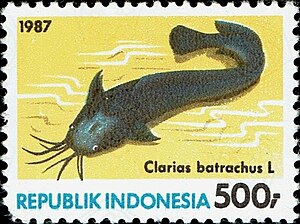
Catfish are used in septic tanks in Indonesia, to eat the waste and slow the tank's filling up with solids.
Aid agencies, individuals and governments have built many latrines in Indonesia, sometimes on a large scale during reconstruction (e.g. Nias and Aceh, post-tsunami). The latrines have septic tanks to break down the waste (at least partially) before the water is discharged. However, septic tanks need to be desludged periodically - where the sludge is sucked out with a desludging truck. This can be a problem when no desludging truck is available, or when no dumping site is available. This leads to overflowing septic tanks, causing environmental and public health problems.
A traditional solution for desludging septic tanks is placing freshwater catfish fingerlings (catfish = ikan lele in Indonesian) into the septic tanks, to reduce the rate at which it fills with sludge. The catfish eat the sewage sludge. About 10 fingerlings may be placed in one septic tank. After a year, the catfish will have grown to a large size.
If the catfish are to be eaten, obviously there are health issues. The catfish might be placed in flowing water for some time - it is unclear how long they need to be there for, or how much difference this makes to taste and safety.
Suggested projects:
- How efficient are catfish at processing sewage, compared to other processes (such as septic tanks, or activated sludge)? Would they be of use in municipal sewage treatment?[expansion needed]
- Have they been (or can they be) used in a treatment pondW?[expansion needed]
Sources[edit | edit source]
- The Indonesian Wikipedia article on catfish (as of 2006) mentioned that freshwater catfish are used to remove impurities from water, and the method of placing them in clean flowing water after removal from the septic tank.
- Personal conversations - Chriswaterguy, 2006.